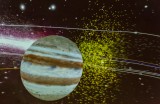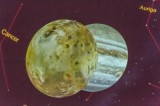Showing off Jupiter and the spring sky
Tuesday night’s Planetarium show took viewers for a ride across space to see Jupiter and its moons, as well as some of the features that our spring sky will offer, in a show titled “Jupiter and the Spring Sky.”

Tuesday’s planetarium show brought viewers into the orbit of Jupiter, using Mt. Hood’s digital projection system.
As usual, the show began with an informational slideshow so the audience could learn more about the night’s subjects. Pat Hanrahan, Planetarium director, described how Jupiter moves across constellations throughout the year. Currently it is located in Gemini, but by the end of this year it will move clear over to Leo.
The “star” of the night, Jupiter, is actually a gas giant. Within the planet, the gas gets thicker and thicker and turns to liquid. Deep inside, the liquid gets even thicker and eventually turns into a solid.
The surface of the planet is covered in winds swirling in opposite directions, and the winds themselves cause Jupiter’s signature Great Red Spot.
Hanrahan said something unusual happened to the planet in 2010: its South Equatorial Belt disappeared. However, the Belt reappeared by 2013, and he said it came back “very strongly.”
Another interesting Jupiter trait is that it has a very strong magnetic field, which acts as a force field, Hanrahan said. The magnetic field is so strong because of the hydrogen in its core. If you get hydrogen cold enough, it will turn into a solid, as is the case within Jupiter. Solid hydrogen under pressure will conduct electricity very well, he said.
Hanrahan showed off Jupiter’s very thin rings, which many observers might not even realize exist. Jupiter was struck by a comet in the 1990s, and this caused there to be a ripple effect on the rings. Even today, the ripples are visible.
Jupiter’s four moons — Io, Europa, Ganymede and Callisto — range from balls of ice to solid rock chunks covered in sulfur, he said. Ganymede is the largest moon in our solar system, and Callisto has spots on its surface where the impact from meteors gouged up clean ice.
Europa, a big, gas ball, has no craters because it is “resurfacing itself a lot,” Hanrahan said. He said he believes “there’s something alive on it” because there is the possibility of a very deep ocean of water beneath the surface, and there “could be life there.”
Hanrahan explained how to find Jupiter: Simply look for the brightest star in the sky. It is “unbelievably bright in the sky, early evening,” he said.
Moving on, he displayed a variety of galaxies, including the Virgo cluster of galaxies and the Pinwheel Galaxy, and a black hole caused by the collapse of a star in the M83 Galaxy.
While the material of this month’s show was a bit on the dry side, compared to February’s, viewers again likely departed with a greater understanding of one of our solar system’s planets.
Next month’s show will focus on Mars, “a very fun planet to explore,” Hanrahan said.
Planetarium shows run on the first Tuesday of every month.
Shows are at 6, 7:15 and 8:30 p.m. and cost $2 for the general public. Admission is free for students and MHCC staff.

Leave a comment